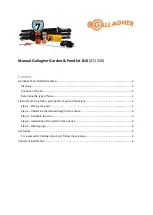
Project Engineering
42
Procedure when working with table 8.2.2:
Required
b
S
C
RO
a
Known
a, S
C
RO
a, b
S
C
RO
, b
1.
In the left column,
search the row with the
known value
a
Select the next smallest
b
-value
Select the next smallest
b
-value
2.
In the relevant
row, search the column
with the next highest
value for
C
RO
In the relevant
column, search the row
with the next highest
value for
a
In the relevant
column, search the row
with the next lowest
value for
C
RO
3.
At the bottom end
of the column, you will
find the relevant
value for
b
At the point of intersec-
tion between row and
column, you will find the
value for
C
RO
In this row, go to the left
column. Here, you will
find the value for
a
.
NOTE!
• If the actual values for a and b are between the values in the table, the next highest value
from the table must be selected.
• A top safety field edge of under 900 mm does not provide adequate protection against
bypassing or crossing over.
• A bottom safety field edge of over 300 mm does not provide adequate protection against
crawling through.
DANGER!
Risk of personal injury or property damage in case of non-compliance with the safety
field specifications!
The system’s safety function is disabled.
Personal injury and damage to equipment may occur.
• Observe the safety field specifications!
Sample calculation:
An ESPE with a resolution of 30 mm and a SFH of 1,500 mm (SEFG420) is to be used to safeguard the area.
The required safety clearance must be calculated.
• Response time of the ESPE
t
1
= 16.2 ms
• Over-travel time of the safety switching device t
2
= 15 ms
• Machine over-travel time
t
3
= 300 ms
• Resolution of the ESPE
d = 30 mm
• Height of the danger zone
a = 1,600 mm
• Reference height
H = 100 mm
• Height of the safety field above ground
b = 1,600 mm (SFH + H)
















































